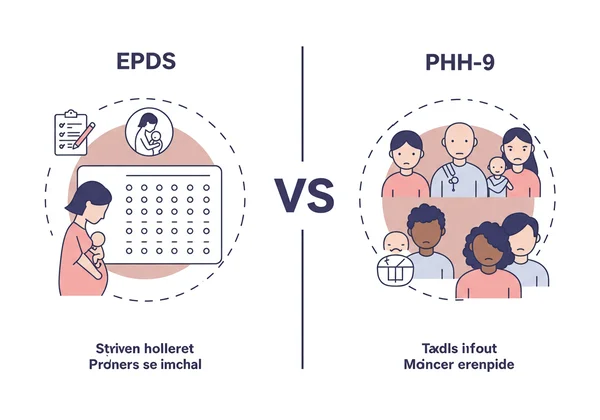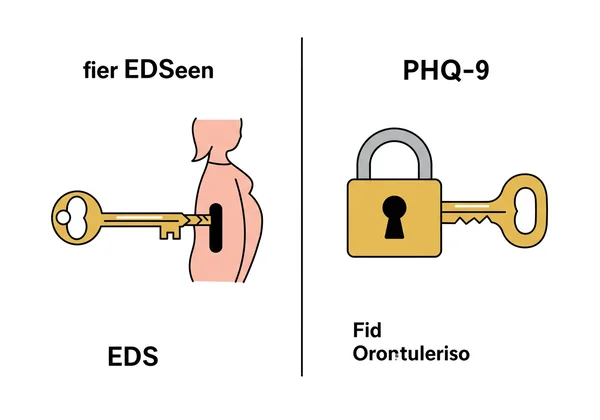EPDS vs. PHQ-9: Perinatal Depression Screening Tools
Navigating the emotional landscape of pregnancy and postpartum can be challenging, and recognizing changes in your mental health is a crucial act of self-care. When it comes to mental health screening, you may encounter different tools, leaving you to wonder about their purpose and accuracy. This guide compares two key assessments, the Edinburgh Postnatal Depression Scale (EPDS) and the Patient Health Questionnaire-9 (PHQ-9), to help you understand their differences. So, what is the difference between PHQ9 and EPDS? By exploring their uses, strengths, and specific applications, you can become more informed about why one is often preferred for perinatal mental health screening.
Understanding these tools is the first step toward empowerment. An informed choice can help you or a loved one take proactive steps in managing mental well-being during this transformative life stage. If you are looking for a reliable way to check in with your emotional health, you can take our free screening to get confidential results in minutes.

What is EPDS? The Edinburgh Postnatal Depression Scale
The epds scale is a globally recognized and widely used screening tool specifically designed to identify women at risk for perinatal depression. It is a 10-item questionnaire that asks a mother about her feelings over the past seven days. Unlike general depression screeners, its questions are carefully crafted to be sensitive to the unique emotional experiences of pregnancy and the postpartum period. This focus makes it an invaluable resource for new mothers, families, and healthcare providers.
Purpose, Development, and Structure of the EPDS
Developed in 1987 by Cox, Holden, and Sagovsky, the edinburgh postnatal depression scale epds was created to address the lack of suitable tools for detecting depression in new mothers. The creators recognized that standard depression symptoms could overlap with normal postpartum experiences, like fatigue or changes in appetite. The EPDS was structured to distinguish between these and the more specific emotional symptoms of depression, such as guilt, anxiety, and an inability to experience pleasure (anhedonia). Its 10 questions are straightforward, making the epds questionnaire easy to complete and score.

How EPDS Scores are Interpreted & What They Mean
Understanding epds scoring is key to its utility. Each of the 10 questions is scored on a scale from 0 to 3, leading to a maximum possible score of 30. A higher score suggests a greater likelihood of depressive symptoms. While cutoff points can vary slightly by region and clinical practice, a common approach to epds score interpretation is:
- Score of 0-9: Typically considered in the low-risk range.
- Score of 10-12: Suggests the possible presence of depression; monitoring and follow-up are recommended.
- Score of 13 or higher: Indicates a high probability of depression, and a comprehensive professional assessment is strongly advised. It is critical to remember that the EPDS is a screening tool, not a diagnostic one. The score helps identify risk, empowering you to start a conversation with a healthcare professional.
Strengths & Limitations in Perinatal Screening
The primary strength of the EPDS is its specificity for perinatal mental health in mothers. It has been validated in numerous languages and cultural contexts, making it a reliable global standard. The scale is sensitive enough to detect symptoms that might otherwise be dismissed as "baby blues." However, its main limitation is that it is not a diagnostic instrument. A high score requires follow-up with a qualified professional to confirm a diagnosis of postpartum depression and create a treatment plan.
Understanding PHQ-9: The Patient Health Questionnaire
The Patient Health Questionnaire-9, or PHQ-9, is another widely used self-administered tool for screening, monitoring, and measuring the severity of depression. Unlike the EPDS, the PHQ-9 is a general depression screening tool used across the adult population in various healthcare settings, not just for perinatal care. It is valued for its brevity and direct alignment with the diagnostic criteria for major depressive disorder.
Origin and Focus on Major Depressive Disorder
The PHQ-9 was derived from a larger health questionnaire and is based directly on the nine diagnostic criteria for major depressive disorder listed in the Diagnostic and Statistical Manual of Mental Disorders (DSM-IV). Its purpose is to quickly assess the presence and severity of depressive symptoms over the past two weeks. This direct link to diagnostic criteria makes it a powerful tool in primary care and mental health clinics for the general population.

Scoring and Clinical Significance of PHQ-9
The nine items on the PHQ-9 are scored from 0 ("not at all") to 3 ("nearly every day"), resulting in a total score ranging from 0 to 27. The clinical significance of the score is generally interpreted as follows:
- 1-4: Minimal depression
- 5-9: Mild depression
- 10-14: Moderate depression
- 15-19: Moderately severe depression
- 20-27: Severe depression These categories help clinicians quickly gauge the level of care a patient may need, from watchful waiting to active treatment with therapy or medication.
Common Applications and Suitability for Adults
The PHQ-9 is a versatile tool used in a broad range of settings. It is commonly found in primary care offices, where it helps doctors screen for depression during routine visits. Mental health professionals also use it to track a patient's progress over the course of treatment. While highly effective for the general adult population, its suitability for perinatal women is often debated because its questions about sleep and energy levels can be confounded by the normal physical changes of pregnancy and new motherhood.
Comparing EPDS & PHQ-9: Key Differences & Similarities
While both the EPDS and PHQ-9 aim to detect depressive symptoms, their design, focus, and application differ significantly. The most important distinction lies in their target populations. The EPDS is the specialist, finely tuned for the perinatal period, while the PHQ-9 is the generalist, effective across a broader audience. Understanding these differences is crucial for ensuring that pregnant and postpartum women receive the most accurate and compassionate care.

Perinatal Specificity vs. General Depression Screening
The core difference is specificity. The EPDS was designed from the ground up to screen for epds postpartum depression, carefully avoiding questions about physical symptoms (somatic symptoms) like fatigue or appetite changes that are common and normal after childbirth. The PHQ-9, however, includes these somatic symptoms, which can inflate scores in new mothers and lead to a false positive for depression. This makes the EPDS a more accurate screener for this specific population, as it hones in on the emotional and cognitive signs of distress.
Addressing Anxiety Symptoms: Does EPDS Screen for Anxiety?
This is a common and important question. While the EPDS is primarily a depression screener, several of its questions can also identify symptoms of anxiety. For instance, questions about feeling scared or panicky for no good reason (Question 3), feeling overwhelmed (Question 6), and self-blame (Question 2) often correlate with anxiety. Research has shown that a subscale of the EPDS (questions 3, 4, and 5) can be an effective screener for perinatal anxiety, a condition that frequently co-occurs with depression. The PHQ-9 is less focused on anxiety symptoms.
Administration, Length, and Scoring Nuances
Both questionnaires are brief and easy to administer. The EPDS consists of 10 questions, while the PHQ-9 has 9. Both can be completed in under five minutes. The scoring nuances, however, reflect their different purposes. The EPDS asks about feelings over the past week, capturing a recent snapshot of a mother's emotional state. The PHQ-9 asks about the past two weeks to align with the diagnostic timeframe for a major depressive episode. The EPDS also includes a crucial final question about thoughts of self-harm, which requires immediate attention if answered affirmatively. You can see how these questions are framed in a real-world context with an online EPDS test.
Choosing the Right Tool: Informing Your Perinatal Mental Health Journey
When it comes to your mental health during pregnancy and after birth, using the right tool matters. While the PHQ-9 is valuable in many contexts, the EPDS is widely considered the gold standard for perinatal depression screening. Its tailored approach provides a more accurate and nuanced picture of a new mother's well-being, reducing the risk of misinterpretation.
Clinical Recommendations for Perinatal Care
Most major health organizations, including the American College of Obstetricians and Gynecologists (ACOG), recommend universal screening for perinatal depression using a validated tool like the EPDS. When should EPDS screening be done? It is often recommended at least once during pregnancy and again during the postpartum period, typically at the 6-week checkup. This proactive approach helps in the early identification and management of mental health challenges, leading to better outcomes for both mother and baby.
Self-Screening for Awareness vs. Professional Diagnosis
Taking an online screening test is a powerful step toward self-awareness. Tools like the free EPDS screening on our site offer a confidential and accessible way to check in with your emotions. However, it's vital to understand the difference between screening and diagnosis. A screening tool identifies risk, while a professional diagnosis can only be made by a qualified healthcare provider after a thorough evaluation. Your results are a starting point for a conversation, not a final answer.
Key Takeaways: Empowering Your Perinatal Mental Health Journey
Choosing between the EPDS and PHQ-9 is not just a clinical decision; it's about using the most appropriate and sensitive tool for the unique journey of motherhood. The EPDS stands out as the superior choice for perinatal screening due to its specific design, which accounts for the realities of the postpartum experience. It empowers mothers and healthcare providers with more accurate information, paving the way for timely support and care.
By understanding these tools, you are better equipped to advocate for your own mental health or that of a loved one. If you're noticing changes in your emotional well-being, know that taking the first step is brave. We're here to support you; consider taking our confidential screening today. This small, supportive step can open the door to the resources you deserve.
Frequently Asked Questions About Perinatal Depression Screening
What is EPDS, and how does it differ from PHQ-9?
The EPDS (Edinburgh Postnatal Depression Scale) is a 10-item questionnaire specifically designed to screen for depression in pregnant and postpartum women. It differs from the PHQ-9, a general depression screener for adults, by focusing on emotional symptoms and avoiding physical ones that are common after childbirth, providing a more accurate risk assessment for perinatal depression.
Does the EPDS screen for anxiety as well as depression?
Yes, while its primary focus is depression, the EPDS is also effective at identifying symptoms of anxiety. Several of its questions inquire about feelings of fear, panic, and being overwhelmed, which are key indicators of anxiety. A subset of its questions is often used as a validated screener for perinatal anxiety.
What is considered a "normal" EPDS score?
A score between 0 and 9 is generally considered to be in the low-risk range and is often referred to as "normal." However, any score that reflects a change in your well-being is worth discussing with a healthcare provider. A score of 10 or higher suggests a possible risk for depression and warrants a follow-up conversation.
How long does the EPDS test usually take to complete?
The EPDS test is very brief. Most individuals can complete the 10-question survey in less than five minutes. This makes it an efficient and accessible tool for both clinical settings and online self-screening.
Is the online EPDS test free to use?
Yes, the online epds test offered on our site is completely free, confidential, and accessible. Our goal is to provide a user-friendly platform where you can get your EPDS score instantly, along with clear explanations and guidance on the next steps to take for your mental well-being.